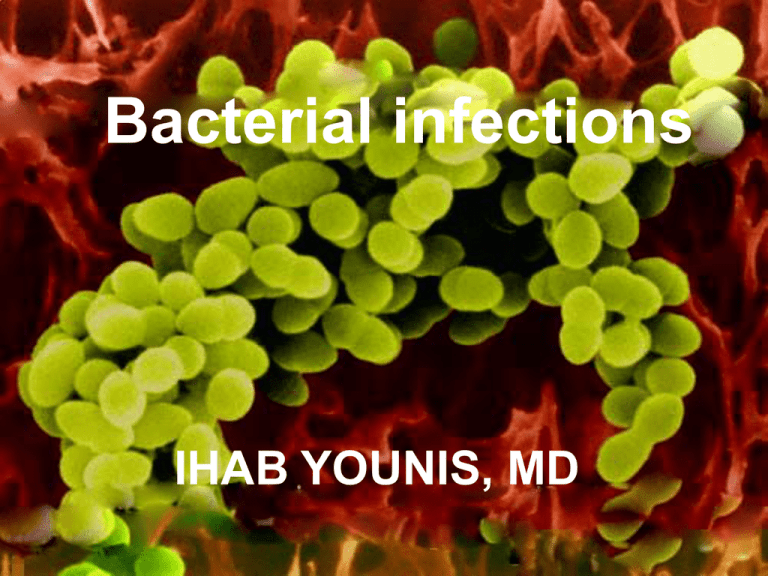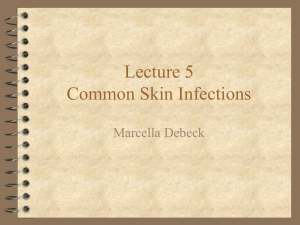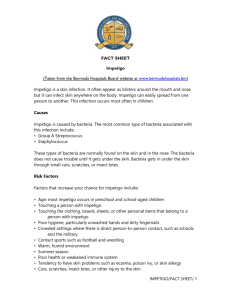Etiology
advertisement

Bacterial infections IHAB YOUNIS, MD Impetigo Etymology: L. a scabby eruption Incidence • The most common skin infection in children. Approximately 9-10% of all children presenting to clinics with skin complaints have impetigo • The majority (90%) of bullous impetigo cases occur in children younger than 2 years Etiology • Caused by -Staphylococcus aureus -Streptococci (group A beta-hemolytic) or • Staph aureus is cultured consistently from the lesions, but streptococci are found only occasionally • The infection may be caused by a mixture of the 2 organisms • Strept rarely act as the sole causative agents, as was believed 10 years ago • The organisms are thought to enter through damaged skin and are transmitted through direct contact • After infection, new lesions may be seen on the patient with no apparent break in the skin • Usually there is a predisposing factor e.g. miliaria or scabies Staphylococci Streptococci Clinically I-Impetigo contagiosa(non-bullous impetigo): The lesions begin with a single 2- to 4-mm erythematous macule that rapidly evolves into a vesicle or a pustule • This vesicle is very fragile and ruptures early, leaving a crusted exudate of a honey or yellow color over the superficial erosion • The infection spreads to contiguous and distal areas through inoculation of other wounds from scratching • Regional lymphadenopathy may be found in impetigo contagiosa II-Bullous impetigo: presents with small or large, superficial, fragile bullae on the trunk and the extremities • Often, only the remnants of ruptured bullae are seen at the time of presentation • Regional lymphadenopathy is rare in bullous impetigo • Fever, diarrhea & generalized weakness may be present in bullous impetigo • The separation of the epidermis is due to an exotoxin produced by staphylococci, which may be the only organism present in cases of bullous impetigo III-Common impetigo is the term applied when the infection occurs in preexisting wounds IV-Ecthyma is a deeper, ulcerated impetigo infection, often occurring with lymphadenitis Complications • Glomerulonephritis due to a nephritogenic strain of streptococci may occur 3 w from infection • Scarlet fever, urticaria and erythema multiforme may follow impetigo Histopathology Subcorneal blister full of neutrofills Bacteria and neutrophills are found in the st.corneum Treatment • Topical antibiotics: in mild cases i.e. lesions that are small or few in number • Systemic antibiotics: If the lesions are widespread or accompanied by lymphadenopathy or if nephritogenic strept are suspected • The antibiotic chosen should be active against staph and strept Cellulitis&Erysipelas Etymology: G., fr. [erythros,] red + [pella,] skin Erysipelas Normal Cellulitis Etiology • Streptococci (group A) are predominant • Staph. Aureus are occasional in cellulitis but rare in erysipelas Clinically • Cellulitis most commonly develops on the legs but can occur anywhere • The first symptoms are erythema, pain, and tenderness over an area of skin • The infected skin becomes hot and slightly swollen and may look slightly pitted, like an orange peel • Most people with cellulitis feel only mildly ill, but some may have a fever, chills, rapid heart rate, headache, low blood pressure, and confusion • Vesicles or bullae may appear on the infected skin • Erysipelas starts abruptly & systemic symptoms may be severe but responds rapidly to treatment • The skin is bright red and noticeably swollen and the edges of the infected area are raised. The swelling occurs because the infection blocks the lymphatic vessels in the skin Complications . Bacteremia with seeding of bone, joints or brain . Abscesses .Superinfection . Lymphangitis . Thrombophlebiti . Gas-forming cellulitis . Thrombophlebitis . Necrotizing fasciitis Differential diagnosis • Deep vein thrombosis -Protein level in aspirate of tissue fluid is >10 g/L -Phlebography and Doppler Investigations • Most patients do not require laboratory study • Consider the following tests in patients with moderate to severe cellulitis (ie, patients requiring admission or requiring parenteral antimicrobials) 1-CBC counts often show leukocytosis greater than 13,000 WBC/cc 2-Obtain a blood culture only if the patient is admitted or has significant systemic symptoms or if concern of bacteremia exists 3-Strongly consider culture in all patients requiring admission or parenteral antibiotics Treatment • Penicillin G procaine: 0.6-1.2 million U IM bid for 10 d • Amoxicillin and clavulanate (Augmentin) for infections caused by penicillinase-producing staphylococci: 500-875 mg PO bid • Erythromycin (Erythrocin) For penicillin sensitive patients :750-100 mg/d orally for 10 d Staphylococcal Scalded Skin Syndrome SSSS (Lyell's disease) Etiology • Described in 1956 by Alan Lyell as toxic epidermal necrolysis (TEN) • Caused by two epidermolytic toxins (A and B) produced by phage group 2 Staphylococcus aureus Clinically • Most common in children (98% are younger than 6 years). It is rare in adults • Originates from a focus of infection that may be a purulent conjunctivitis, otitis media, or occult nasopharyngeal infection • Begins with fever, irritability, and a generalized, faint, orange-red, macular erythema with cutaneous tenderness • Within 24-48 hours, the rash progresses from scarlatiniform to blistering • Characteristic tissue paper–like wrinkling of the epidermis is followed by the appearance of large, flaccid bullae in the axillae, in the groin and around the body orifices • A positive Nikolsky sign (slippage of the superficial layer of the epithelium on gentle pressure) can often be elicited at this stage • As sheets of epidermis are shed, a moist erythematous base is revealed • Healing is usually complete within 5-7d • In adults, it is frequently followed by bacteremia and pneumonia, favoring a poor prognosis Histopathology Separation between gran.&Malpig.layers Investigations • ELISA can identify the toxins responsible • Culture from initial sites Treatment • • • • • Antibiotics in pediatric doses e.g.: Penicillin G procaine :600,000-1 million U/d IM Amoxicillin and clavulanate (Augmentin): 500 mg PO q12h or 250 mg PO q8h Cephalexin (Keflex): 25-50 mg/kg/d q6h Gentamicin (Garamycin): <5 years with normal renal function: 2.5 mg/kg/dose IV/IM q8h >5 years: 1.5-2.5 mg/kg/dose q8h or 6-7.5 mg/kg/d divided q8h Erythromycin (Erythrocin): 30-50 mg/kg/d Erythrasma Etymology: G. [erythraino,] to redden Etiology • The Gram-positive, aerobic diphtheroid Corynebacterium minutissimum ,which is present as a normal skin flora • Corynebacteria invade the upper one-third of the stratum corneum • Predisposing factors include excessive sweating, obesity & diabetes mellitus Clinically • The incidence of erythrasma is reported to be around 4% • The typical appearance is well-demarcated, brown-red macular patches • The skin has a wrinkled appearance with fine scales • Infection commonly is located over inner thighs, axillae, submammary area, periumbilical region, • Toe web lesions appear as maceration • Infection commonly is asymptomatic, but it can be pruritic • Duration ranges from months to years • Widespread involvement of trunk and limbs is possible Investigations • Wood’s light examination • Coral-red fluorescence of lesions is observed due to to the production of porphyrin by these diphtheroids • Results may be negative if patient bathed prior to presentation • Gram stain reveals gram-positive rods Treatment • Erythromycin (Erythrocin): 500 mg PO bid for 7-10 d • Fusidic acid (Fucidin):Apply to affected area bid for 2 wk • Miconazole (Daktarin): Apply to affected area bid for 2 wk Folliculitis 1-Superficial folliculitis Etiology • It is an inflammation confined to the ostium of hair follicle • Caused by coagulase-positive staphylococci (impetigo of Bockhart) or Physical (epilation) or Chemical irritation (mineral oils, tar or adhesive plaster) Clinically • The primary lesion is a papule or pustule with a central hair ,the hair shaft may not be seen • Typical body sites affected are the face, scalp, thighs, axilla, and inguinal area Treatment • Topical and oral antibiotics. If a patient does not improve after a 2-4 week course , the case must be investigated (cultures, Gram stain, KOH prep and biopsy) • Washing with antibacterial soaps (eg, Betadine skin cleanser) • For recurrent and recalcitrant folliculitis, antibiotic ointment in the nasal vestibule twice a day for 5 days 2-Pseudofolliculitis Etiology • Pseudofolliculitis barbae is a foreign body inflammatory reaction involving papules and pustules affecting curly haired males who shave • Pseudofolliculitis pubis is a similar condition occurring after shaving pubic hair • Two mechanisms are involved in the pathogenesis : (1) extrafollicular penetration occurs when a curly hair reenters the skin and (2) transfollicular penetration occurs when the sharp tip of a growing hair pierces the follicle wall Clinically • The primary lesion is a flesh-colored or erythematous papule with a hair shaft in its center. If the hair shaft is gently lifted up, the free end of the hair comes out of the papule • Pustules and abscess formation can occur from secondary infection • Postinflammatory hyperpigmentation, scarring, and keloid formation may occur in chronic or improperly treated cases Treatment 1-Chemical depilatories: • They work by breaking the disulfide bonds in hair, which results in the hair being broken off bluntly at the follicular opening • Chemical depilatories should be used every second or third day because they cause skin irritation – Barium sulfide powder depilatories 2% paste with water and applied to the beard area. This paste is removed after 3-5 minutes – Calcium thioglycolate preparations come as powder, lotions, creams, and pastes. They are left for 10-15 minutes; chemical burns result if left on too long. The mercaptan odor is often masked with fragrance 2-Topically applied tretinoin (Retin-A): When used nightly, it alleviates hyperkeratosis removing the thin covering of epidermis that the hair becomes embedded in upon emerging from the follicle 3-Mild topical corticosteroid creams: Reduce inflammation of papular lesions 4-Topical antibiotics: In severe cases Reduce skin bacteria and treat secondary infection These topicals include erythromycin (Acnebiotic), clindamycin (Dalacin-T) and benzamycin(Akneroxide) 5-Stoping shaving for 4-6 w is the most effective method but it is temporary 3-Furunccle (Abcess) Etymology: L. [furunculus,] a petty thief Etiology • It is an acute infection involving an entire hair follicle and the adjacent subcutaneous tissue • Caused by Staphylococcus aureus, but as it is present in the nares&perineum, infection may reflect a defect in surface defence i.e. balance between microflora • Predisposing factors may include malnutrition but diabetes is doubtful Clinically • Most common on the face, neck, armpit, buttocks and thighs • Begins as a follicular, tender, red nodule but ultimately becomes fluctuant • It may drain spontaneously or surgically, producing pus • Furuncles can be very painful (throbbing) if they occur in areas like the ear canal or nose • Furuncles can be single or multiple. Some people have recurrent bouts • Less common symptoms include:fever, fatigue or malaise Treatment • Topical and systemic penicillinaseresistant antibiotics • Warm moist compresses encourage furuncles to drain, which speeds healing • Large lesions may need to be drained surgically 4-Carbuncle Etymology: L. carbunculus ,small glowing ember Etiology • It is a deep infection of a group of neighboring hair follicles extending to connective tissue and subcutaneous fat • Caused by Staphylococcus aureus • Predisposing factors may include malnutrition, diabetes, heart failure or during prolonged steroid therapy Clinically • Painful, acutely tender, red, dome-shaped lump • It reaches a diameter of 3-10 cm in a few days • Suppuration starts and pus is discharged from multiple follicular orifices • Constitutional symptoms are severe • They may be solitary or multiple • Most leasions are on the back of neck, shoulders, hips and thighs • Healing leaves a scar but in debilatated cases death may occur due to toxemia Treatment • Systemic penicillinase-resistant antibiotics • Large lesions may need to be drained surgically • Treatment of predisposing factors 5-Acne kelodalis Nuchae (folliculitis keloidalis) Etiology • The findings of Sperling et al(2000) indicate that AK is a primary form of scarring alopecia • Many of the histologic findings closely resemble those found in certain other forms of scarring alopecia • They claim that overgrowth of microorganisms does not play an important role in the pathogenesis • They also found no association between pseudofolliculitis barbae and AK Herzberg et al (1990) provided another explanation: •The acute inflammation, whether it begins in the sebaceous gland or the deep portion of hai follicle , leads to a weakened follicular wall at these levels • This enables the release of hair shafts into the surrounding dermis. The "foreign" hairs incite further acute and chronic granulomatous inflammation • The localized granulomatous inflammation manifests itself clinically as a papular lesion • Fibroblasts lay down collagen and scars form in the region of the inflammation • Distortion and occlusion of the follicular lumen by fibrosis leads to hair retention in the inferior follicle and further granulomatous inflammation and scarring Older speculations: • Injury produced by short haircuts (especially when the posterior hairline is shaved with a razor • Curved hair follicles (analogous to pseudofolliculitis of the beard • Constant irritation from shirt collars, chronic lowgrade bacterial infections, and an autoimmune process (AK usually responds to systemic steroid therapy) clinically • Starts after puberty as firm, dome-shaped, follicular papules or pustules that are 2-4 mm in diameter • The papules develop on the nape of the neck and/or on the occipital part of the scalp • Some papules remain discrete but others coalesce to form keloid-like plaques, which are usually arranged in a bandlike distribution at or below the posterior part of the hairline • Early papular lesions are usually asymptomatic, but pustular lesions are often pruritic and occasionally painful • Scarring alopecia and subcutaneous abscesses with draining sinuses may also be present Dermal fibrosis Hair shafts surrounded by granulomatous inflammation Larger magnification Treatment • Advise patients not to get the occipital part of their hairline edged with a razor or wear tight fitting shirts • Twice-a-day treatment with a combined retinoic acid (Retin-A) and a strong steroid cream may be sufficient to relieve all symptomatology and flatten the existing lesions • When pustules, crust formation is present, use topical clindamycin on a twice-daily basis until the pustules abate and the inflammation subsides. If the patient does not have significant improvement in 4-5 days, take a bacterial culture of the involved area, and start the appropriate systemic antibiotic • Intralesional steroid injections (10-40 mg/mL) are another method of therapy. They seem to be painful on the posterior part of the scalp, and the fibrotic tissue is difficult to inject. Injections are easier if the papules are electrodesiccated and curetted first. Using a dental syringe or pressure syringe (Derma-Jet or Meda-Jet) sometimes makes it easier to inject. Warn patients that the area injected might become hypopigmented and stay that way for 6-12 months • Laser therapy (carbon dioxide or Nd:YAG) has been successful for some patients. Postoperative intralesional triamcinolone injections (10 mg/mL q2-3wk) help prevent recurrence. Cryotherapy has also proven to be successful in some cases. The area is frozen for 20 seconds, allowed to thaw and is then frozen again a minute later • Once healing has taken place, apply a tretinoin-fluorinated steroid mixture to the occipital part of the scalp twice daily to help prevent recurrence • Surgical intervention followed by intralesional steroids Pitted keratolysis Etiology • Caused by Kytococcus sedentarius,Dermatophilus congolensis, or species of Corynebacterium and Actinomyces • Under appropriate conditions (ie, prolonged occlusion, hyperhidrosis, increased skin surface pH), K sedentarius proliferates and produces 2 keratin-degrading proteinases that destroy the stratum corneum, creating pits • The malodor associated is presumed to be due to the production of sulfur by-products, such as thiols, sulfides, and thioesters Clinically • Pits in the stratum corneum ranging from 0.5-7.0 mm in size seen on pressurebearing areas of the plantar surface • Patients may complain of malodor, hyperhidrosis and occasionally, soreness or itching as in military personnel Treatment • Limit the use of occlusive footwear • Absorbent cotton socks must be changed frequently to prevent excessive foot moisture • Twice daily applications of erythromycin or clindamycin are effective. Either solutions or gel formulations may be used • Oral erythromycin is another option • For resistant cases and/or associated with hyperhidrosis, the use of botulinum toxin injections has been effective Anthrax Etymology: G. anthrax (anthrak-), charcoal Etiology • Caused by B anthracis ,a gram-positive bacillus • Cutaneous anthrax results from exposure to the spores of Bacillus anthracis after handling sick herbivorous animals, contaminated wool or hair • Pulmonary anthrax results from inhaling anthrax spores • Intestinal anthrax results from ingesting meat products that contain anthrax spores Clinically 1-Cutaneous anthrax"malignant pustule": • Begins as a pruritic papule that enlarges in 24-48 hours to form an ulcer with a raised edematous edge surrounded by a satellite lesions • 80% of patients who are not treated recover 2-Inhalational anthrax : • After initial mild symptoms improvement, it progresses rapidly with high fever, severe shortness of breath, tachypnea, cyanosis, profuse diaphoresis, hematemesis, and chest pain, which may be so severe as to mimic an acute myocardial infarction • It leads to septicemia as the organisms released from the liver or spleen into the bloodstream overwhelm host defenses and produce massive amounts of lethal toxin that result in shock and death 3-Intestinal anthrax: Patients complain of nausea, vomiting, malaise, anorexia, abdominal pain, hematemesis, and bloody diarrhea, which are accompanied by fever Investigations • The preferred diagnostic procedure for cutaneous anthrax is staining the ulcer exudate with methylene blue or Giemsa stain • B anthracis readily grows on blood agar Treatment • Penicillin G procaine : 600,000-1,000,000 U/d IM for 60 d • Doxycycline (Vibramycin) :100 mg PO/IV q12h for 60 d • Ciprofloxacin (Ciprobay): 500 mg PO q12h for 60 d (no clinical experience) • Antimicrobial therapy renders lesions culturenegative within hours, but the lethal effects of anthrax are related to the effects of the organism's toxin Suppurative hidradenitis Etiology Many theories 1-Infective etiology • Strept., staph. & E. coli have been identified in the early stages of the disease; however, in the chronic relapsing stages, anaerobic bacteria and Proteus species have more commonly been isolated • Whether the bacteria are the cause or the result of the disease has not been determined 2-Hormonal theory: Improvement and relapse after pregnancy and contraceptive pill intake suggest that low levels of estrogens predisposes for hidradenitis suppurativa 3-Immune theory: Immunity in most patients is intact, but some patients demonstrate a defect in the T-cell lymphocytes 4-Genetic theory: Increased incidence in individuals with HLA-A1 and HLA-B8 has been demonstrated in some patients The Pathogenesis of Hidradenitis Suppurativa Keratin comedones Occlusion of the apocrine duct Superimposed inflammation and infection Abscess formation Chronic infection and spread Induration and sinus and fistula formation Clinically • It affects skin-bearing apocrine glands : Axilla,groin, perineum ,perianal region,buttocks,scrotum submammary region The onset is usually after puberty, in the 2nd&3rd decades • Early lesions are solitary, painful pruritic nodules that may persist for weeks or months without any change • The nodules develop into pustules&eventually rupture, draining purulent material.This leads to chronic sinus formation, with intermittent release of serous, purulent, or bloodstained discharge • If subcutaneous extension occurs, it may appear as indurated plaques, which in lax skin, such as the axilla and groin, manifest as linear bands. Multiple sites may be simultaneously affected • Comedones may be present Treatment • Tetracycline and erythromycin may be helpful on a long-term basis • Cephalosporins often will help in acute cellulitis • Sulfonamide or clindamycin antibiotic are used in presence of methicillin-resistant staphylococcus aureus in both short-term and long-term treatment • Topical products, such as benzoyl peroxide, may be helpful • Retin-A has been found to be helpful in some patients • Isotretinoin (Accutane) : Decreases sebaceous gland size and sebum production; may also inhibit abnormal keratinization .Adult Dose 40-60 mg/d PO for 4m • Topical steroids to modify the body's immune response • In severe cases, radical excision of the pathologic tissue with split-thickness skin grafts Actinomycosis Etymology:G. aktinos, a ray of light + G. myk , fungus, + -osis, condition Etiology • Actinomyces israelii is a gram-positive, non– spore-forming anaerobic bacillus • Its filamentous growth and mycelia-like colonies have a striking resemblance to fungi • They are soil organisms, often found in decaying organic matter • It is primarily a commensal found in normal oral cavities, in tonsillar crypts, in dental plaques and in carious teeth Clinically • • • • • • 1-Cervicofacial actinomycosis: The most common manifestation, comprising 5070% of reported cases Occurs following oral surgery or in patients with poor dental hygiene In the initial stages soft-tissue swelling of the perimandibular area occurs Nodules may be tender in the initial stages, but typically they are nontender and woody hard in the later stages Lymphadenopathy typically is absent. Fever is variably present • Direct spread into the adjacent tissues occurs over time, along with development of fistulas that discharge purulent material containing yellow (ie, sulfur) granules • Invasion of the cranium or the bloodstream may occur if the disease is left untreated 2-Thoracic actinomycosis: • Presents as a pulmonary infiltrate or mass, which, if left untreated, can spread to involve the pleura, pericardium, and chest wall, ultimately leading to the formation of sinuses that discharge sulfur granules 3-Actinomycosis of abdomen and pelvis: • Paients have a history of recent or remote bowel surgery • Presents classically as a slowly growing tumor. Involvement of any abdominal organ, including the abdominal wall, can occur by direct spread, with eventual formation of draining sinuses Histopathology "Sulfur granule": colony of Actinomyces israeli showing slender, periph Gram positive filaments Investigations • A Gram-stained smear of the specimen may demonstrate the presence of beaded, branched, gram-positive filamentous rods, suggesting the diagnosis. • Cultures should be placed immediately under anaerobic conditions and incubated for 48 hours or longer; the isolation and definitive identification of actinomycetes may require 23 weeks • Examining sulfur granules stained with 1% methylene-blue solution, and examined microscopically for features characteristic of actinomycetes Treatment • Penicillin G 12-24 million U/d IV by continuous infusion • Doxycycline (Vibramycin): For nonpregnant patients with penicillin allergy. 100 mg PO q12h • Clindamycin (Dalacine c) : Alternative in patients allergic to penicillin. 150-300 mg PO q8h • Amoxicillin/Clavulanic Acid (Augmentin): can be used alone in mild to moderately severe cases of actinomycosis; covers both pathogenic actinomycetes and companion bacteria, which frequently are resistant to penicillin. 500 mg PO q8h or 875 mg PO q12h









